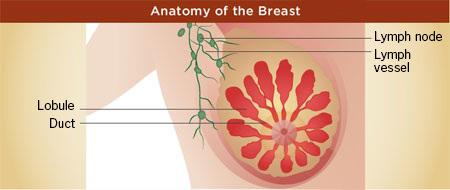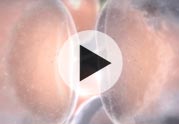The female breast is made up of many glands called lobules. Lobules produce milk that is sent to the nipple through small tubes called ducts. Many breast cancer tumors begin in the cells that line these ducts. Other tumors start in cells lining the lobules. These are known as ductal cancer and lobular cancer, respectively.

Breast cancer is the most common type of cancer among women. In 2016, almost 250,000 new cases of breast cancer are expected to be diagnosed in the United States. It is the second-leading cause of cancer death in women after lung cancer. Breast cancer also affects men, but at a much lower rate. Nearly 2,600 new cases of breast cancer are expected to be diagnosed in men in 2016.
Most masses found in the breast are benign. This means they are not cancerous, or malignant. Benign masses in the breast do not spread to nearby tissues or to other parts of the body. But they may grow in size. Malignant tumors are cancers and can spread to other parts of the body.
The type of treatment you will get depends on many factors, including the type and stage of your tumor. Breast cancer can be treated with surgery, chemotherapy (chemo), hormone therapy, radiation therapy, and targeted therapy. Your doctor will discuss which treatment is right for you.
Chemo Can Cause Side Effects
Chemo stops or slows the growth of cancer cells. Often, cancer cells are fast growing. But chemo also damages healthy cells that divide quickly. These healthy cells can include cells in the bone marrow that make blood, cells in the lining of the gut and mouth, and hair cells. Damage to healthy cells is what causes many chemo side effects. Here's how it works:
- When chemo damages healthy blood cells, the result can be:
- anemia (low red blood cells), which could make you feel extremely weak or tired
- neutropenia (low white blood cells), which could leave you open to infection
- thrombocytopenia (low platelets), which may cause bruising or bleeding
- Chemo may damage healthy cells in the stomach. The chemo medications then irritate these areas, which could result in nausea and vomiting. Chemo medications may also trigger signals in the brain that tell your body to vomit.
- When chemo affects healthy cells surrounding hair follicles, the result can be hair loss. Hair loss is also known as alopecia.
Chemo can cause many other side effects, but the good news is that there may be ways to manage them.
Learn more about chemo side effects and how to manage them.
|
A Closer Look: Lara*
 |
|---|
| Lara is diagnosed with stage III breast cancer. She has surgery to remove the tumor and her breast. Her doctor prescribes a course of adjuvant chemotherapy to kill any remaining cancer cells. |
| Her doctor chooses a regimen known to cause certain chemo side effects. |
These include:
|
| Lara speaks with her doctor about what she can do to help lower the risk of these chemo side effects. |
| Lara's doctor creates a plan to help manage these chemo side effects. |
| Lara is given a list of what to eat and drink and what to avoid on chemo days. |
| Lara arranges ahead of time to have a neighbor take care of her kids the evenings she has chemo treatments. |
*This is a fictional case study based on chemo patient experiences. Your experience is unique. Your doctor and care team will create a plan that will best treat your type of cancer and manage your chemo side effects.
Learn more about managing the side effects of chemo and speak with your doctor and care team to plan for managing chemo side effects.
Check out these questions to help you prepare.
Click here for a discussion guide about chemo and infection to use with your healthcare team.
-
The Chemotherapy and Infection Discussion Guide can help you understand your
risk of infectionInfection can be a serious side effect of strong chemo. Find out the factors that affect your risk of infection. Simply answer a few questions, and then print your results to share with your doctor.
Use the Chemotherapy and Infection Discussion Guide to find out more.

 Enlarge
Enlarge Email
Email Print
Print
